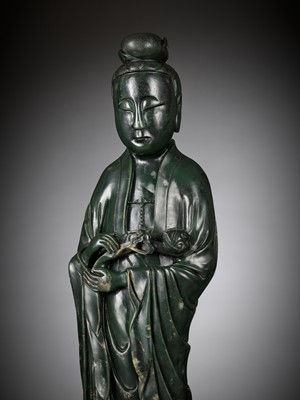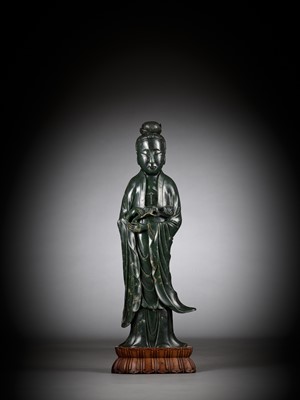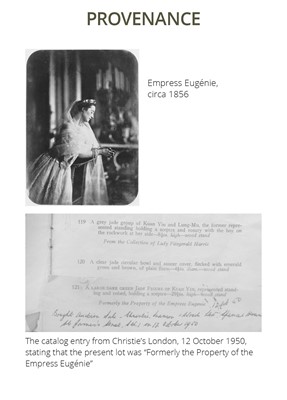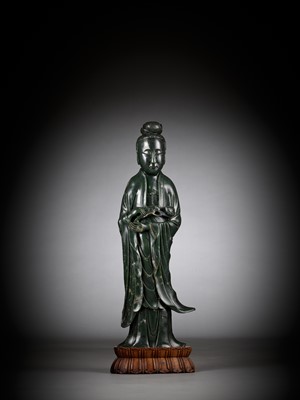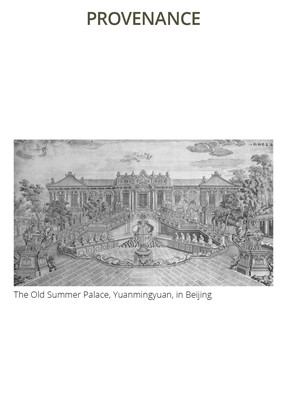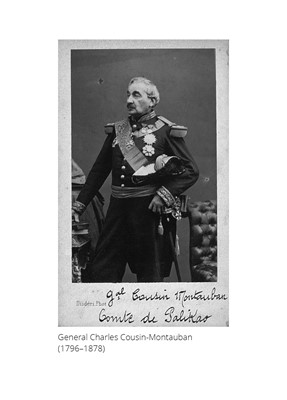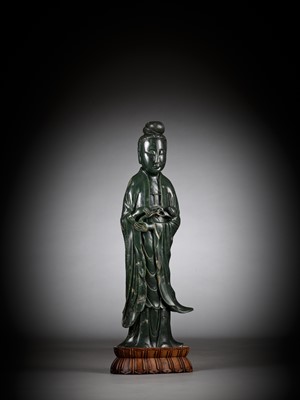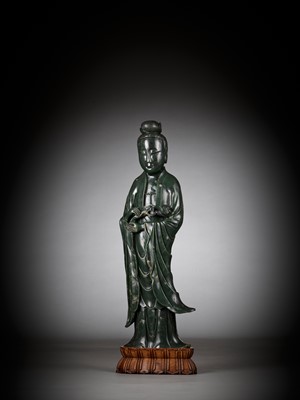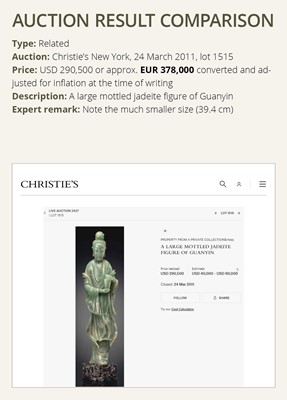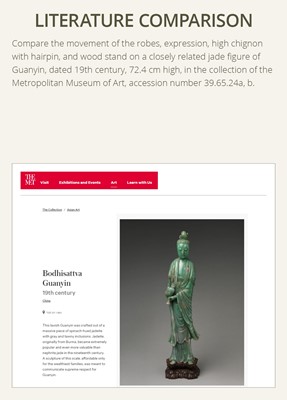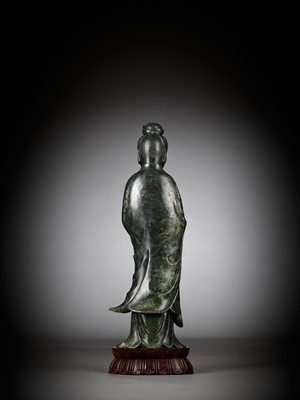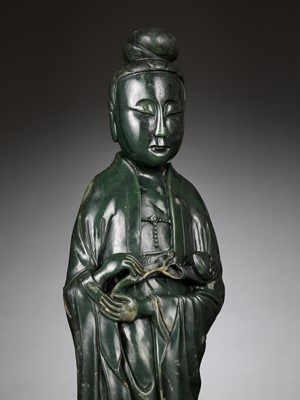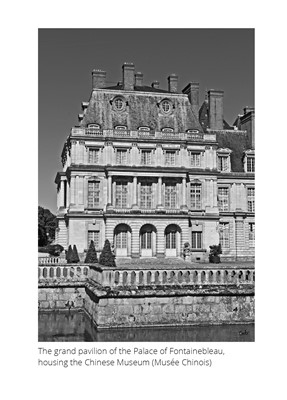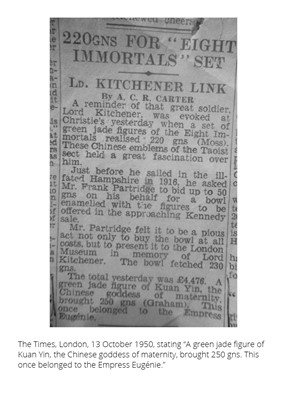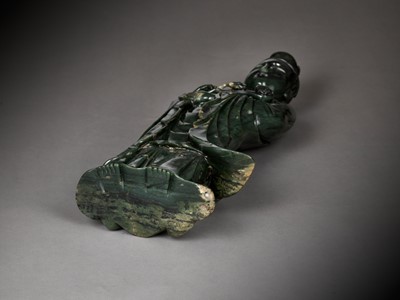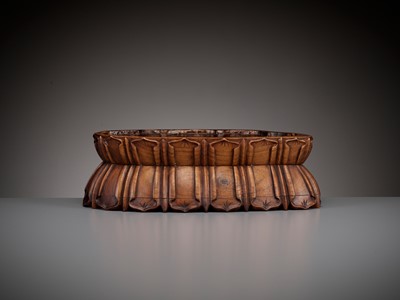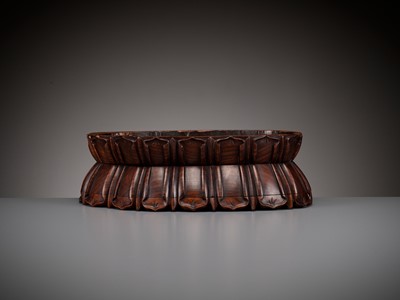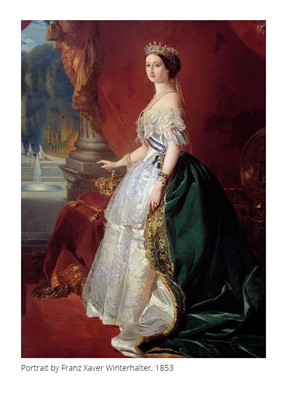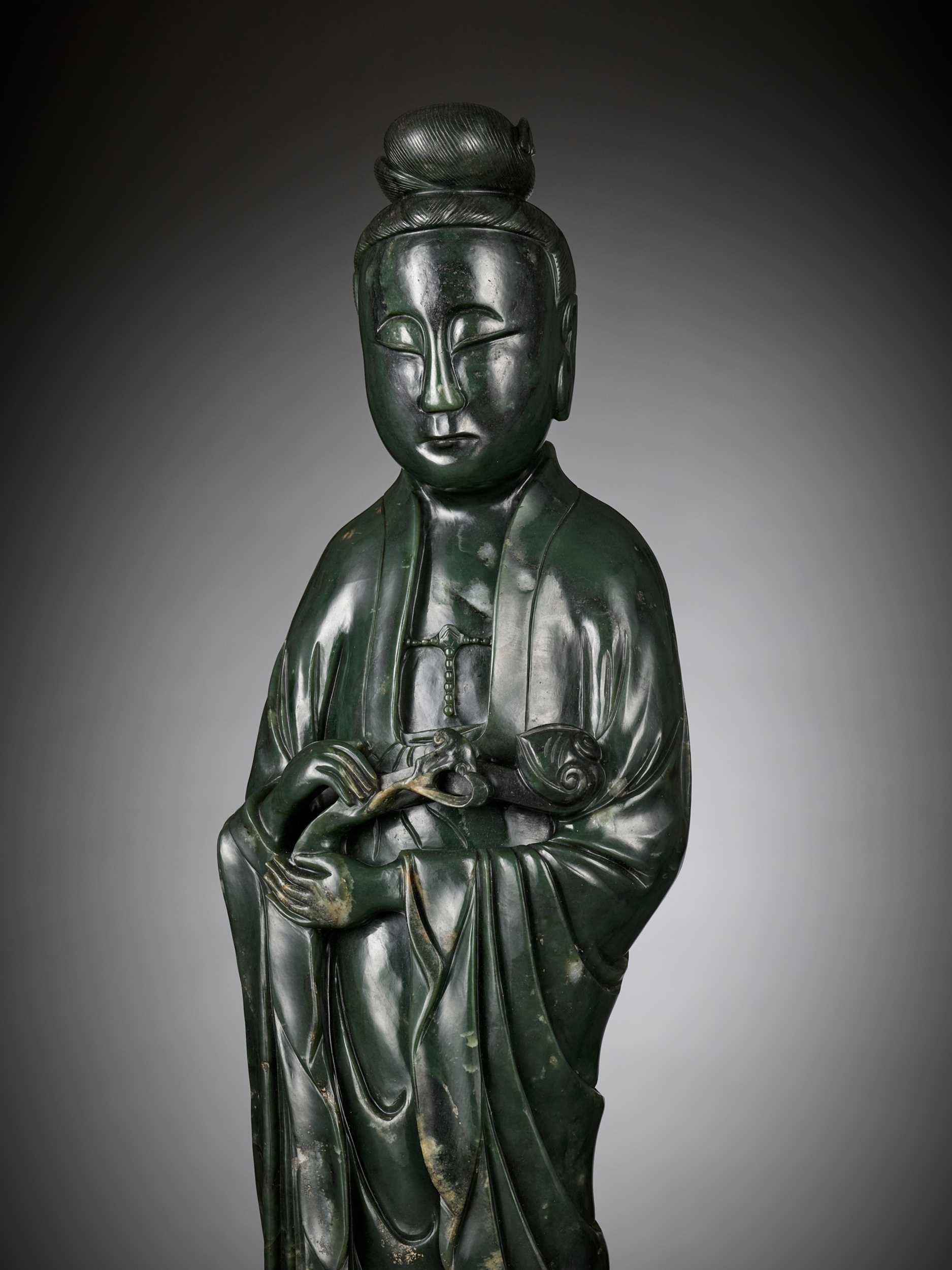29th Sep, 2022 13:00
DAY 1 - TWO-DAY AUCTION - Fine Chinese Art / 中國藝術集珍 / Buddhism & Hinduism
61
A LARGE AND MASSIVE SPINACH-GREEN KHOTAN JADE FIGURE OF GUANYIN, PROBABLY TAKEN FROM THE OLD SUMMER PALACE IN BEIJING IN 1861
大型和田碧玉觀音立像,可能來自1861年圓明園之劫
Sold for €84,500
including Buyer's Premium
China, ca. mid-18th to mid-19th century. Finely carved standing, cradling a lingzhi sprig and ruyi scepter in her delicate hands, wearing a long flowing robe cascading in voluminous folds, her serene face with heavy-lidded eyes, the neatly incised hair tied up into a high chignon secured by a ruyi-head hairpin. The stone of a deep spinach-green tone with creamy, russet, and cloudy inclusions.
Provenance: Eugénie de Montijo (1826-1920), Empress of the French from her marriage to Emperor Napoleon III, and thence by descent in the family. Christie's London, 12 October 1950, lot 121. The Graham Collection, London, acquired from the above and thence by descent in the 1970s to a private English collector. A copy of the lot entry in the Christie’s London auction catalog from 12 October 1950, stating the present lot was “Formerly the Property of the Empress Eugenie” and with handwritten notes by a previous owner, accompanies this lot.
It is probable that the present statue was originally located at the Old Summer Palace, Yuanmingyuan, in Beijing and subsequently part of the loot of several hundred pieces sent to Empress Eugénie directly by General Charles Cousin-Montauban (1796–1878).
In the morning of 21 September 1860 General Cousin-Montauban was the commanding officer of the Anglo-French troops, fighting the battle at the bridge of Palikao against the Qing Imperial forces, a decisive event of the Second Opium War. Their victory allowed the Western forces to take the Chinese capital Beijing and eventually defeat the Qing Empire. On 6 October 1860, French and British troops captured the Old Summer Palace, looting the Imperial collections over the next few days, again under the command of General Cousin-Montauban.
In 1861, General Charles Cousin-Montauban sent numerous crates of the enormous French loot of the Summer Palace to Empress Eugénie in France as a personal gift to the Imperial French household, with the first shipment arriving in February 1861. The inventory of this shipment numbers some 800 objects, with over 300 coming directly from the sack of the Summer Palace. As a reward, the general eventually received the title of Comte de Palikao by Emperor Napoleon III in 1862.
In 1863, the Empress established a museum of Chinese art called the Musée Chinois (Chinese Museum) at the Palace of Fontainebleau. She carefully curated the collections and displays of this museum, at the time almost exclusively consisting of the objects taken from the Old Summer Palace in 1860. In later years, Eugénie combined the Chinese collection with gifts originating from the French embassies in Siam, Cambodia, Japan, Korea, and Tibet to collectively form the core of the Asian art collection in Fontainebleau, which she later complemented with objects confiscated by the state during the French Revolution and kept since then at the National Library, some diplomatic and non-diplomatic gifts, and acquisitions she made on the French art market using the Imperial household's personal budget. The museum has been preserved in a layout largely similar to that of the 1860s and is one of the world's oldest museums specifically dedicated to Asian art. It is unknown which and how many of the pieces from the museum went with Empress Eugénie to England after her husband was overthrown in 1870, but there are speculations that the amount was quite substantial.
Empress Eugénie of France was born María Eugenia Ignacia Agustina de Palafox y Kirkpatrick, 19th Countess of Teba, 16th Marchioness of Ardales, in Granada, Spain. She was Empress of the French from her marriage to Emperor Napoleon III on 30 January 1853 until the Emperor was overthrown on 4 September 1870. Napoléon and Eugénie had one child together, Napoléon, Prince Imperial (1856–79). After the fall of the Empire, the three lived in exile in England. Eugénie outlived both her husband and son and spent the remainder of her life working to commemorate the Second French Empire. After World War I, Eugenie lived long enough to see the collapse of other European monarchies, such as those of Russia, Germany and Austria-Hungary. She left her house in Farnborough with all her collections to the heir of her son, Prince Victor Bonaparte.
Published: The Times, London, 13 October 1950, a column in the paper relating to various jades in the Christie's sale including this figure of Guanyin from Princess Eugenie which sold at 250 Guineas (at the time, the cost of house in London averaged at ca. 1.500 Guineas). A copy of a newspaper clipping with this column accompanies this lot.
Condition: Very good condition with some old wear, natural inclusions and imperfections of the stone, few minuscule nicks here and there, light scratches. The wood base with minor losses, natural age cracks and a fine naturally grown patina.
Weight: c. 24 kg (without the base)
Dimensions: Height 75 cm
With a matching wood base dating from the same period, finely carved with lotus petals. (2)
Literature comparison:
Compare the movement of the robes, expression, high chignon with hairpin, and wood stand on a closely related jade figure of Guanyin, dated 19th century, 72.4 cm high, in the collection of the Metropolitan Museum of Art, accession number 39.65.24a, b.
Auction result comparison:
Type: Related
Auction: Christie’s New York, 24 March 2011, lot 1515
Price: USD 290,500 or approx. EUR 378,000 converted and adjusted for inflation at the time of writing
Description: A large mottled jadeite figure of Guanyin
Expert remark: Note the much smaller size (39.4 cm)
大型和田碧玉觀音立像,可能來自1861年圓明園之劫
中國,約十八世紀中期至十九世紀中期。碧玉觀音髮梳高髻,佩戴如意髮飾;雙目微閉,神情和藹慈祥,法相飽滿。胸前掛瓔珞,著長袍,雙手持靈芝紋如意,立於橢圓形蓮台之上。觀音造像生動傳神,端莊穩重,衣著華美,衣紋飄逸,刀法嫻熟,突出觀音肅穆端莊之氣。玉質溫婉細潤,碧綠色澤沉穩,滋蘊內斂,含絮狀物。
來源:Eugénie de Montijo歐珍妮·德·蒙提荷(1826-1920),是法蘭西第二帝國皇帝拿破崙三世的妻子和法國最後一位皇后,保存在同一家族;倫敦佳士得,1950年10月12日,lot 121;倫敦 Graham Collection,購於拍賣,一直保存至上世紀七十年代被一英國私人收藏家收藏。隨附倫敦佳士得拍賣目錄文字副本,上描述 “Formerly the Property of the Empress Eugenie” (歐珍妮皇后財產)與上任藏家手寫注釋。
這尊碧玉觀音造像很可能來自北京圓明園,是被Charles Cousin-Montauban查爾斯·庫辛-蒙托邦將軍(1796-1878 年)直接送給歐仁妮皇后的數百件戰利品中的一件。
1860 年 9 月 21 日上午,Cousin-Montauban將軍作為英法聯軍指揮官,在八里橋與清軍作戰,這是第二次鴉片戰爭的決定性事件。他們的勝利使西方軍隊佔領了中國北京並最終擊敗了清帝國。1860 年 10 月 6 日,英法聯軍佔領圓明園,在接下來的幾天裡,Cousin-Montauban將軍指揮洗劫了皇家收藏。
1861 年,查爾斯·庫辛-蒙托邦將軍向法國歐珍妮皇后送了數箱來自圓明園的法國戰利品,作為送給法國皇室的個人禮物,第一批貨物於 1861 年 2 月到達。這批貨物的庫存編號大約800件物品,其中300多件直接來自圓明園。作為獎勵,這位將軍最終於 1862 年被拿破崙三世皇帝授予八里橋伯爵頭銜。
1863年,皇后在楓丹白露宮建立了中國藝術博物館,名為Musée Chinois(中國博物館)。她精心策劃了這個博物館的藏品和展品,當時幾乎完全由 1860 年從圓明園搶來的物品組成。後來,歐珍妮將中國藏品與來自法國駐柬埔寨暹羅大使館的禮物結合,日本,韓國和西藏共同構成了楓丹白露亞洲藝術收藏的核心。之後她補充了法國大革命期間國家沒收的物品,並從那時起保存在國家圖書館,其中包括一些外交和非外交禮物,以及她使用皇室的個人預算在法國藝術市場上進行的收購。該博物館的佈局與 1860 年代的佈局大體相似,是收藏亞洲藝術的最古老的博物館之一。 1870 年,拿破侖三世被推翻後,博物館的哪些藏品和多少件隨她前往英國尚不得而知,但有人猜測數量相當可觀。
歐珍妮皇后來自西班牙一個沒落貴族家庭,是第十九代特瓦女公爵、第十六代阿爾達萊斯女侯爵。1853年1月30日,她和剛剛稱帝的拿破崙三世舉辦了盛大的婚禮,歐珍妮成為了法國末代皇后。婚後,她生下一個嬰兒即她的獨子拿破崙四世。1870年普法戰爭爆發,共和派領導民眾推翻了第二帝國,歐珍妮皇后帶著她的收藏流亡海外。1873年,拿破崙三世逝世。緊接著1878年,她唯一的兒子在南非祖魯戰爭中意外陣亡。歐珍妮皇后深受打擊,漸漸開始了隱居的生活,直到1920年自己去世,享年94歲。歐珍妮皇后對法國的時尚歷史文化影響深遠。歐珍妮皇后的餘生都在努力紀念法蘭西第二帝國。第一次世界大戰後,歐珍妮的壽命足以見證其他歐洲君主制的崩潰,例如俄羅斯、德國和奧匈帝國。她帶著她所有的收藏品離開了她在範堡羅的家,交給了她兒子維克多·波拿巴王子的繼承人。
出版:1950年10月13日倫敦《泰晤士報》刊登了一篇專欄文章,講述佳士得拍賣會上的各種玉器,包括這尊歐珍妮皇后的碧玉觀音像,售價為 250 吉尼(當時倫敦的平均房價約為 1.500 吉尼)。隨附一份剪報副本。
品相:狀況極好,有一些磨損、玉料瑕疵,有些微小的刻痕,輕微的劃痕。木底座帶有缺損、天然年代裂紋和包漿。
重量:約24公斤(不含底座)
尺寸:高75 厘米
木質蓮花底座。
文獻比較:
比較一件非常相近的十九世紀清晚期翡翠雕觀音立像(高72.4 厘米),有木底座,飄然的衣紋、表情、頭髮高梳為髻,以髮飾固定,收藏於大都會藝術博物館,編號39.65.24a, b。
拍賣結果比較:
形制:相近
拍賣:紐約佳士得,2011年3月24日,lot 1515
價格:USD 290,500(相當於今日EUR 378,000)
描述:大型翡翠雕觀音立像
專家評論:請注意尺寸較小(39.4厘米)。
#videohighlight
China, ca. mid-18th to mid-19th century. Finely carved standing, cradling a lingzhi sprig and ruyi scepter in her delicate hands, wearing a long flowing robe cascading in voluminous folds, her serene face with heavy-lidded eyes, the neatly incised hair tied up into a high chignon secured by a ruyi-head hairpin. The stone of a deep spinach-green tone with creamy, russet, and cloudy inclusions.
Provenance: Eugénie de Montijo (1826-1920), Empress of the French from her marriage to Emperor Napoleon III, and thence by descent in the family. Christie's London, 12 October 1950, lot 121. The Graham Collection, London, acquired from the above and thence by descent in the 1970s to a private English collector. A copy of the lot entry in the Christie’s London auction catalog from 12 October 1950, stating the present lot was “Formerly the Property of the Empress Eugenie” and with handwritten notes by a previous owner, accompanies this lot.
It is probable that the present statue was originally located at the Old Summer Palace, Yuanmingyuan, in Beijing and subsequently part of the loot of several hundred pieces sent to Empress Eugénie directly by General Charles Cousin-Montauban (1796–1878).
In the morning of 21 September 1860 General Cousin-Montauban was the commanding officer of the Anglo-French troops, fighting the battle at the bridge of Palikao against the Qing Imperial forces, a decisive event of the Second Opium War. Their victory allowed the Western forces to take the Chinese capital Beijing and eventually defeat the Qing Empire. On 6 October 1860, French and British troops captured the Old Summer Palace, looting the Imperial collections over the next few days, again under the command of General Cousin-Montauban.
In 1861, General Charles Cousin-Montauban sent numerous crates of the enormous French loot of the Summer Palace to Empress Eugénie in France as a personal gift to the Imperial French household, with the first shipment arriving in February 1861. The inventory of this shipment numbers some 800 objects, with over 300 coming directly from the sack of the Summer Palace. As a reward, the general eventually received the title of Comte de Palikao by Emperor Napoleon III in 1862.
In 1863, the Empress established a museum of Chinese art called the Musée Chinois (Chinese Museum) at the Palace of Fontainebleau. She carefully curated the collections and displays of this museum, at the time almost exclusively consisting of the objects taken from the Old Summer Palace in 1860. In later years, Eugénie combined the Chinese collection with gifts originating from the French embassies in Siam, Cambodia, Japan, Korea, and Tibet to collectively form the core of the Asian art collection in Fontainebleau, which she later complemented with objects confiscated by the state during the French Revolution and kept since then at the National Library, some diplomatic and non-diplomatic gifts, and acquisitions she made on the French art market using the Imperial household's personal budget. The museum has been preserved in a layout largely similar to that of the 1860s and is one of the world's oldest museums specifically dedicated to Asian art. It is unknown which and how many of the pieces from the museum went with Empress Eugénie to England after her husband was overthrown in 1870, but there are speculations that the amount was quite substantial.
Empress Eugénie of France was born María Eugenia Ignacia Agustina de Palafox y Kirkpatrick, 19th Countess of Teba, 16th Marchioness of Ardales, in Granada, Spain. She was Empress of the French from her marriage to Emperor Napoleon III on 30 January 1853 until the Emperor was overthrown on 4 September 1870. Napoléon and Eugénie had one child together, Napoléon, Prince Imperial (1856–79). After the fall of the Empire, the three lived in exile in England. Eugénie outlived both her husband and son and spent the remainder of her life working to commemorate the Second French Empire. After World War I, Eugenie lived long enough to see the collapse of other European monarchies, such as those of Russia, Germany and Austria-Hungary. She left her house in Farnborough with all her collections to the heir of her son, Prince Victor Bonaparte.
Published: The Times, London, 13 October 1950, a column in the paper relating to various jades in the Christie's sale including this figure of Guanyin from Princess Eugenie which sold at 250 Guineas (at the time, the cost of house in London averaged at ca. 1.500 Guineas). A copy of a newspaper clipping with this column accompanies this lot.
Condition: Very good condition with some old wear, natural inclusions and imperfections of the stone, few minuscule nicks here and there, light scratches. The wood base with minor losses, natural age cracks and a fine naturally grown patina.
Weight: c. 24 kg (without the base)
Dimensions: Height 75 cm
With a matching wood base dating from the same period, finely carved with lotus petals. (2)
Literature comparison:
Compare the movement of the robes, expression, high chignon with hairpin, and wood stand on a closely related jade figure of Guanyin, dated 19th century, 72.4 cm high, in the collection of the Metropolitan Museum of Art, accession number 39.65.24a, b.
Auction result comparison:
Type: Related
Auction: Christie’s New York, 24 March 2011, lot 1515
Price: USD 290,500 or approx. EUR 378,000 converted and adjusted for inflation at the time of writing
Description: A large mottled jadeite figure of Guanyin
Expert remark: Note the much smaller size (39.4 cm)
大型和田碧玉觀音立像,可能來自1861年圓明園之劫
中國,約十八世紀中期至十九世紀中期。碧玉觀音髮梳高髻,佩戴如意髮飾;雙目微閉,神情和藹慈祥,法相飽滿。胸前掛瓔珞,著長袍,雙手持靈芝紋如意,立於橢圓形蓮台之上。觀音造像生動傳神,端莊穩重,衣著華美,衣紋飄逸,刀法嫻熟,突出觀音肅穆端莊之氣。玉質溫婉細潤,碧綠色澤沉穩,滋蘊內斂,含絮狀物。
來源:Eugénie de Montijo歐珍妮·德·蒙提荷(1826-1920),是法蘭西第二帝國皇帝拿破崙三世的妻子和法國最後一位皇后,保存在同一家族;倫敦佳士得,1950年10月12日,lot 121;倫敦 Graham Collection,購於拍賣,一直保存至上世紀七十年代被一英國私人收藏家收藏。隨附倫敦佳士得拍賣目錄文字副本,上描述 “Formerly the Property of the Empress Eugenie” (歐珍妮皇后財產)與上任藏家手寫注釋。
這尊碧玉觀音造像很可能來自北京圓明園,是被Charles Cousin-Montauban查爾斯·庫辛-蒙托邦將軍(1796-1878 年)直接送給歐仁妮皇后的數百件戰利品中的一件。
1860 年 9 月 21 日上午,Cousin-Montauban將軍作為英法聯軍指揮官,在八里橋與清軍作戰,這是第二次鴉片戰爭的決定性事件。他們的勝利使西方軍隊佔領了中國北京並最終擊敗了清帝國。1860 年 10 月 6 日,英法聯軍佔領圓明園,在接下來的幾天裡,Cousin-Montauban將軍指揮洗劫了皇家收藏。
1861 年,查爾斯·庫辛-蒙托邦將軍向法國歐珍妮皇后送了數箱來自圓明園的法國戰利品,作為送給法國皇室的個人禮物,第一批貨物於 1861 年 2 月到達。這批貨物的庫存編號大約800件物品,其中300多件直接來自圓明園。作為獎勵,這位將軍最終於 1862 年被拿破崙三世皇帝授予八里橋伯爵頭銜。
1863年,皇后在楓丹白露宮建立了中國藝術博物館,名為Musée Chinois(中國博物館)。她精心策劃了這個博物館的藏品和展品,當時幾乎完全由 1860 年從圓明園搶來的物品組成。後來,歐珍妮將中國藏品與來自法國駐柬埔寨暹羅大使館的禮物結合,日本,韓國和西藏共同構成了楓丹白露亞洲藝術收藏的核心。之後她補充了法國大革命期間國家沒收的物品,並從那時起保存在國家圖書館,其中包括一些外交和非外交禮物,以及她使用皇室的個人預算在法國藝術市場上進行的收購。該博物館的佈局與 1860 年代的佈局大體相似,是收藏亞洲藝術的最古老的博物館之一。 1870 年,拿破侖三世被推翻後,博物館的哪些藏品和多少件隨她前往英國尚不得而知,但有人猜測數量相當可觀。
歐珍妮皇后來自西班牙一個沒落貴族家庭,是第十九代特瓦女公爵、第十六代阿爾達萊斯女侯爵。1853年1月30日,她和剛剛稱帝的拿破崙三世舉辦了盛大的婚禮,歐珍妮成為了法國末代皇后。婚後,她生下一個嬰兒即她的獨子拿破崙四世。1870年普法戰爭爆發,共和派領導民眾推翻了第二帝國,歐珍妮皇后帶著她的收藏流亡海外。1873年,拿破崙三世逝世。緊接著1878年,她唯一的兒子在南非祖魯戰爭中意外陣亡。歐珍妮皇后深受打擊,漸漸開始了隱居的生活,直到1920年自己去世,享年94歲。歐珍妮皇后對法國的時尚歷史文化影響深遠。歐珍妮皇后的餘生都在努力紀念法蘭西第二帝國。第一次世界大戰後,歐珍妮的壽命足以見證其他歐洲君主制的崩潰,例如俄羅斯、德國和奧匈帝國。她帶著她所有的收藏品離開了她在範堡羅的家,交給了她兒子維克多·波拿巴王子的繼承人。
出版:1950年10月13日倫敦《泰晤士報》刊登了一篇專欄文章,講述佳士得拍賣會上的各種玉器,包括這尊歐珍妮皇后的碧玉觀音像,售價為 250 吉尼(當時倫敦的平均房價約為 1.500 吉尼)。隨附一份剪報副本。
品相:狀況極好,有一些磨損、玉料瑕疵,有些微小的刻痕,輕微的劃痕。木底座帶有缺損、天然年代裂紋和包漿。
重量:約24公斤(不含底座)
尺寸:高75 厘米
木質蓮花底座。
文獻比較:
比較一件非常相近的十九世紀清晚期翡翠雕觀音立像(高72.4 厘米),有木底座,飄然的衣紋、表情、頭髮高梳為髻,以髮飾固定,收藏於大都會藝術博物館,編號39.65.24a, b。
拍賣結果比較:
形制:相近
拍賣:紐約佳士得,2011年3月24日,lot 1515
價格:USD 290,500(相當於今日EUR 378,000)
描述:大型翡翠雕觀音立像
專家評論:請注意尺寸較小(39.4厘米)。
#videohighlight
Zacke Live Online Bidding
Our online bidding platform makes it easier than ever to bid in our auctions! When you bid through our website, you can take advantage of our premium buyer's terms without incurring any additional online bidding surcharges.
To bid live online, you'll need to create an online account. Once your account is created and your identity is verified, you can register to bid in an auction up to 12 hours before the auction begins.
Intended Spend and Bid Limits
When you register to bid in an online auction, you will need to share your intended maximum spending budget for the auction. We will then review your intended spend and set a bid limit for you. Once you have pre-registered for a live online auction, you can see your intended spend and bid limit by going to 'Account Settings' and clicking on 'Live Bidding Registrations'.
Your bid limit will be the maximum amount you can bid during the auction. Your bid limit is for the hammer price and is not affected by the buyer’s premium and VAT. For example, if you have a bid limit of €1,000 and place two winning bids for €300 and €200, then you will only be able to bid €500 for the rest of the auction. If you try to place a bid that is higher than €500, you will not be able to do so.
Online Absentee and Telephone Bids
You can now leave absentee and telephone bids on our website!
Absentee Bidding
Once you've created an account and your identity is verified, you can leave your absentee bid directly on the lot page. We will contact you when your bids have been confirmed.
Telephone Bidding
Once you've created an account and your identity is verified, you can leave telephone bids online. We will contact you when your bids have been confirmed.
Classic Absentee and Telephone Bidding Form
You can still submit absentee and telephone bids by email or fax if you prefer. Simply fill out the Absentee Bidding/Telephone bidding form and return it to us by email at office@zacke.at or by fax at +43 (1) 532 04 52 20. You can download the PDF from our Upcoming Auctions page.
How-To Guides
How to Create Your Personal Zacke Account
How to Register to Bid on Zacke Live
How to Leave Absentee Bids Online
How to Leave Telephone Bids Online
中文版本的操作指南
创建新账号
注册Zacke Live在线直播竞拍(免平台费)
缺席投标和电话投标
Third-Party Bidding
We partner with best-in-class third-party partners to make it easy for you to bid online in the channel of your choice. Please note that if you bid with one of our third-party online partners, then there will be a live bidding surcharge on top of your final purchase price. You can find all of our fees here. Here's a full list of our third-party partners:
- 51 Bid Live
- EpaiLive
- ArtFoxLive
- Invaluable
- LiveAuctioneers
- the-saleroom
- lot-tissimo
- Drouot
Please note that we place different auctions on different platforms. For example, in general, we only place Chinese art auctions on 51 Bid Live.
Bidding in Person
You must register to bid in person and will be assigned a paddle at the auction. Please contact us at office@zacke.at or +43 (1) 532 04 52 for the latest local health and safety guidelines.
